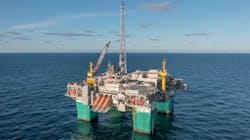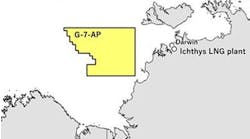Editor's note: This story first appeared in the March-April 2023 issue of Offshore magazine's Energy Transformation Strategies Special Report.
By Ariana Hurtado, Editor and Director of Special Reports
International independent E&P company Neptune Energy started the year off strong with multiple announcements on its CO2 storage initiatives.
Neptune and partner Horisont Energi entered into an option agreement in early January on the location of an onshore terminal for the Errai carbon capture and storage (CCS) project in Norway. Neptune has a 40% owner share in the Errai project. The receiving terminal for intermediate onshore storage of CO2 will be located in Gismarvik on the west coast of Norway. From here, Neptune said carbon would be transported through pipeline to the North Sea, where it would be injected and permanently stored in an offshore reservoir. Errai is the first commercial CO2 storage project in Norway.
Moreover, Horisont and Neptune signed a memorandum of understanding with E.ON in late February with the aim to develop a European CCS value chain. The agreement covers several areas such as project financing, funding and the development of a complete value chain for CO2 handling. If Horisont and Neptune's application for CO2 storage for the Errai project is awarded, the intention is that this will be the first joint project.
Shortly after that company update, Neptune and CapeOmega announced NoordKaap, a project concept for a cross-border CO₂ storage solution for industrial emitters across Europe. According to Neptune, NoordKaap would involve transporting CO2 via vessels suitable for directly injecting the CO2 at offshore locations and for terminal offloading. In addition, RWE has signed a letter of intent with CapeOmega and Neptune to assess the possibility to ship green CO2 from their biomass Eemshaven facility for offshore storage in the Dutch North Sea. NoordKaap is planned to be operational in 2028.
NoordKaap will examine the potential for a network-based approach to CCS via marine transport, and it would provide access to CO2 subsurface storage sites offshore the Netherlands and Norway.
On Feb. 28, Sval and Naptune made announcement regarding an application for a CO2 storage license in the Norwegian North Sea. Securing the license would enable the companies to proceed with the Trudvang project, which has the potential to store up to 9 MMtonnes of CO2e per year to about 20% of Norway’s total annual emissions. The Trudvang project comprises capture of CO2 by multiple industrial emitters in Northern Europe and the UK, shipping of liquid CO2 from export terminals to an onshore receiving terminal in the southwest of Norway, and transport via a purpose-built pipeline to the Trudvang location for injection and permanent storage. The Trudvang storage license is located in the Norwegian North Sea about 200 km from the coast.
Furthermore, Neptune and its partners are currently developing the L10 CCS project in the Netherlands, which could store up to 5 mt of carbon per year in the first phase of development. Neptune also is pursuing CCS storage and appraisal licences in the UK and in Norway.
“Our strategy is to build a competitive CO2 storage portfolio in the North Sea by 2030,” Estensen said. “The L10 CCS project in the Netherlands is the most mature, but we have also applied for new storage acreage in the UK CCS licensing round. In Norway we hope to mature at least two more storage applications by the end of 2023.”
Decarbonization strategies
“Neptune’s integrated energy hub strategy provides an opportunity to drive offshore decarbonization by extending the life of offshore assets and repurposing them to facilitate CO2 storage and hydrogen production, using domestic, lower carbon intensive gas or wind power,” Estensen said. “By extending field life, electrification could become more economic, helping decarbonize existing production further.”
This strategy, he added, builds on the company’s experience with CCS in the Netherlands and Norway.
“At 6kg CO2/boe, the carbon intensity of Neptune’s operated portfolio is already among the lowest in the sector and ahead of the industry average of 15 kg CO2/boe,” he said. “The methane intensity of our operated production is 0.02%, below the industry average of 0.20%, and Neptune remains on target to reach net zero methane emissions by 2030.”
The company aims to store more carbon that it emits by 2030. “We know that gas will continue to play a crucial role in decarbonization globally, while also being vital for energy security," Estensen said. "Our gas-weighted portfolio positions us well, and we will use this to integrate energy systems, increasing CO2 storage, electrification and hydrogen production.”
In November 2022, the UN’s Environmental Program awarded Neptune the Gold Standard status for its plans to cut methane emissions from its operations.
“The Gold Standard status recognizes our robust plans to report and reduce methane emissions for our operated and non-operated assets by 2024 and 2026, respectively,” Estensen explained. “We are taking action as we recognize that reducing methane emissions is one of the most effective ways to limit near-term climate change. Although short-lived in the atmosphere, methane is a potent greenhouse gas, retaining more than 80 times more heat than CO2 in a 20-year timeframe. We already have an industry-leading low-methane intensity, which refers to methane emissions from our operated assets as a percentage of gas exported.”
The company’s actions to reduce methane include reducing routine flaring. Neptune also supports the World Bank’s Zero Routine Flaring by 2030 initiative and conducts leak detection and repair programs to reduce fugitive emissions. In addition, the company is working to enhance methane detection and reporting.
“During 2022, specialists working for the Environmental Defense Fund completed an evaluation of methane emissions data gathered from our Cygnus platform in the UK,” Estensen said. “We plan to conduct further studies in the UK and Norway in 2023 so we can identify an accurate benchmark for measuring total methane emissions and determine what action we can take to reduce them."
Gjøa project updates
Neptune was recently awarded PL1180 in the Gjøa area and PL1179 in the Fram area via the Norwegian Ministry of Petroleum and Energy's APA 2022 licensing round. The license awarded in the Gjøa area has a one-year work program consisting of reprocessing the seismic to mature prospects in the area for a potential tieback to the Gjøa platform. The final drill decision will be taken in the beginning of 2024. Estensen said the license awarded in the Fram area should be viewed as more like an extension license to Fram PL090.
At its operated Gjøa asset in the North Sea, the company is collecting all the gas that during normal operation is being diverted to the atmospheric vent system and recompressing it back into the process, Estensen explained. In addition, the company is regularly using infrared camera technology to detect and remove any small diffuse gas leaks that can occur within process facilities.
“During the coming years, we're also implementing new technology for the gas seals on the compressors where current seals depend on a certain positive flow of gas to operate correctly,” he added. “Regular monitoring for methane over our facilities through the use of drone technology carrying detection systems is also part of the toolbox developed over the last couple of years.”
Hydrogen developments
“As it’s the world’s first pilot on a working platform to integrate three offshore energy systems (gas, wind and green hydrogen), safety studies were the priority. Now we’re working with the Dutch Ministry of Economic Affairs and Climate Policy to increase the percentage of hydrogen in the existing gas grid,” Estensen said. “PosHYdon is also teaching us valuable lessons that we can leverage in future demonstration projects, like H2opZee, toward large-scale green hydrogen production in the North Sea.”
Neptune and RWE signed a joint development agreement in early 2022 to develop the H2opZee offshore green hydrogen project ahead of 2030. H2opZee is a demonstration project that aims to build 300-500 MW electrolyzer capacity in the North Sea to produce green hydrogen using offshore wind. The hydrogen will then be transported to land through an existing pipeline.






